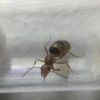I've been thinking about a long term project. I know I want to get a huge terrarium someday. I'm talking 50-90gal tank. (one of the big hang ups is how to put an ant-proof lid on such a tank)
Inside this tank I'd like to have a little slice of eastern temperate forest floor. I've been learning about what ants might work well. As much as I love pennslyvanicus carpenter ants, they are probably too active and prone to growing massive colonies for this project. Are there any US carpenter ant species that are big-n-beefy, but don't get large colonies on year 2+?
For other species I'm thinking something like acorn ants and a Formica species similar to subsericea ... something that won't get a huge colony. A Strumigenys sp. (the miniture trap jaw ants that hunt springtails) could be nice. I'd also like to have a selection of mosses and lichens, interesting isopods, a few little spiders, tons of spring tails would live in the bioactive soil. Snails, millipedes, slugs, and worms would be obvious inclusions. Much of this could be harvested from the forest in my in-laws back yard upstate.
I'd also need to overwinter the entire enclosure.
A Trachymyrmex sp. (one of the temperate fungus growers) would be super neat, though I'd first need to learn how to keep them solo, determine how delicate they are... Just a whole lot of steps.
Another possible "long shot" idea for this environment would be one or two northern brown snakes. These are fairly small snakes that eat worms and snails. Have any of you kept a snake in a terrarium with ants? Would they molest each other?
The goal is max diversity of plants and small creatures, without any one thing taking over, and minimal conflict and unnatural stress.
Have any of you done a similar project or seen one online? This is mostly just a dream at this stage.















